Kai Staats
- Created: Friday, October 12 2018 01:20
 Since the last update on December 15, 2017, there is much to tell about the Mt. Meru Astronomical Observatory. Thank you for your patience and steadfast interest in this important project.
Since the last update on December 15, 2017, there is much to tell about the Mt. Meru Astronomical Observatory. Thank you for your patience and steadfast interest in this important project.
The observatory itself is nearly complete. The telescope pier was set with rebar and concrete nearly two meters deep, isolated from the observatory floor, then finished with four threaded rods ready to receive the 120 kg steel pedestal and telescope.
Cages are mounted at knee-height along the interior walls, protecting low-wattage red lights. Electrical sockets are evenly spaced, to provide power to computers and additional telescopes. The floor offers a beautifully orchestrated terrazzo inset of the Sun, Mercury, Venus, Earth, Mars and asteroid field on the interior of the building. Jupiter is depicted on the exterior floor, beneath the structure that supports the roll-off roof. Saturn, Uranus, Neptune, and possibly Pluto (if the grassy garden is large enough) will be noted with field markers at the appropriate spacing, a pathway encouraging visitors to walk the full solar system.
All of these bodies are placed to within a centimeter of their
average position from the Sun such that visitors to the
observatory can measure the distance on the floor, then
extrapolate the true relationship to our solar system. Only an application of a protective sealant remains, then the floor will come to life.
The paint is now applied to the walls. The massive roll-off roof is fully operational and quite smooth, requiring a good push to make it open and close. Eventually, we'll introduce a motorized system. Electricity is now run to the observatory and provision of Internet is in motion.
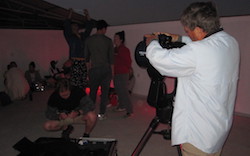 |
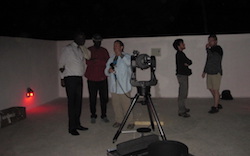 |
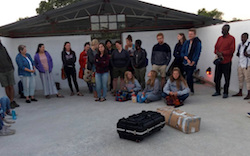 |
In June of this year, Dr. Michael Huster, Assistant Professor and Director of Instructional Labs at Duquesne University, Pittsburgh PA and his students visited the observatory. They brought with them two telescopes and a host of weather monitoring instruments. The clouds parted, treating them to the inky black skies of rural Tanzania for a quality viewing experience.
Our first visitor to the Mt. Meru Astronomical Observatory, Dr. Huster intends to return soon!
 The observatory has seen a long, sometimes challenging, ultimately rewarding journey. Starting in 2013 when the Board of Directors was assembled to build the legal foundation and support for what is now five years design, development, and construction. Thomas Mbise, Aminiel Mungure, Josiah Mariki, Elineema Nassary, Azeal Nasari, Frank Mchuma, Hadian Urio, and Lydia Mbise have contributed many volunteer hours to bring to life the vision shared with Telescopes to Tanzania co-founders–the late Chuck Ruehle, Susan Ruehle, and Mponda Malozo. In November 2015 Kai Staats came on-board to work with contractor Azeal Nasari to design and remotely guide construction of the observatory, which is nearly complete.
The observatory has seen a long, sometimes challenging, ultimately rewarding journey. Starting in 2013 when the Board of Directors was assembled to build the legal foundation and support for what is now five years design, development, and construction. Thomas Mbise, Aminiel Mungure, Josiah Mariki, Elineema Nassary, Azeal Nasari, Frank Mchuma, Hadian Urio, and Lydia Mbise have contributed many volunteer hours to bring to life the vision shared with Telescopes to Tanzania co-founders–the late Chuck Ruehle, Susan Ruehle, and Mponda Malozo. In November 2015 Kai Staats came on-board to work with contractor Azeal Nasari to design and remotely guide construction of the observatory, which is nearly complete.
Telescopes to Tanzania co-founder Susan Ruehle visited the MMAO observatory in August, met with the Board of Directors, and came back to the States with praise for the quality of construction and near completion of the site.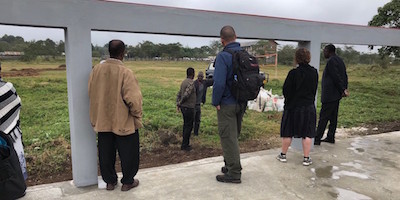 The Telescope
The Telescope
From 2014-18, the Racine Astronomical Society (RAS) conducted a nearly total overhaul of this beautiful late 1960s Cave-Cassegrain instrument (details of this project were provided in previous AWB posts by Chuck Ruehle). Members Dave Finch, Christopher Gray, Brian Jensen, Don Klemt, Shawn Martens, Dave Mogensen, Gary Oaks, Bill Pohnan Jr., Chuck Ruehle, Mark Schmidt, Tim Schumann, Chris Tobias, Leigh Weidner, Gary Wiltsy, Marv Zellmer, and Mike Zweifel contributed countless hours and many layers of expertise to this effort.
The last week of May Kai Staats returned to Racine, Wisconsin with a rented minivan. Over the course of two nights, RAS club members Brian, Dave, Mark, and Leigh carefully packaged the telescope, part-by-part as Kai was given instruction for placement and function.
Fully loaded, the back of the minivan was stacked with a wood shipping palette, steel pedestal, tube, armatures, counter weights, spotting scopes and eyepieces. More than 230 kilograms in all! Kai set off he next morning, driving more than 3000 kilometers through five States to bring this instrument to the home of Dan Heim in New River, Arizona for the final upgrades and fine-tuning.
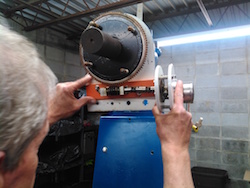 |
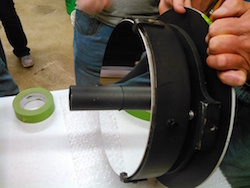 |
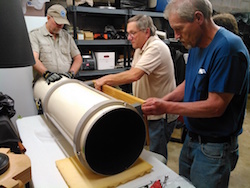 |
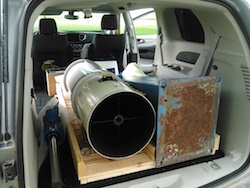 |
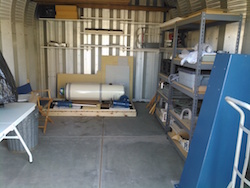 |
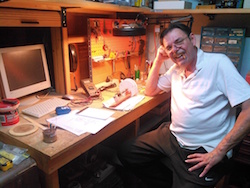 |
Dan, Kai’s former high school physics instructor, is an avid amateur astronomer, instructional blogger (www.sky- lights.org), and expert garage engineer. Dan and Kai are completing the remaining upgrades with intent to ship the telescope to Tanzania by the close of October this year.
The items remaining for completion of the telescope include: holes that need tapping (threads), fabrication of an additional counterweight, mounting of an electrical box to house the 12V power supply, and installation of Right Ascension and Declination drive motors.
The telescope has transmissions in place. They are solid and well built. Dan and Kai are working with Alan Buckman of AWR Technology (www.awrtech.co.uk), Kent, England for the selection of the DC stepper motors, drive shaft machining, and programming of the controllers to correctly match the gear ratios in the existing transmissions. It is anticipated that Alan will ship the motors and shaft fittings by the close of September, at which point Kai and Dan will dive into the final upgrades, assembly, and testing.
Finally, the world famous Lowell Observatory (www.lowell.edu) machine shop has offered to fabricate a new setting circle in contribution to this project. Thank you!
A Shared Story
While this telescope is old by years, every part has been upgraded or improved, including a totally modern drive assembly and tracking system well suited for astro-photography. We intentionally chose to not upgrade the instrument to full GOTO functionality as we believe that using star charts and an eye piece is the best way for learners to engage, learn, and feel at home in the night sky.
It has been suggested more than once that purchasing a new telescope would have been less costly, less time consuming, and far simpler. This is true. But the intent is not simplicity nor saving time. In rebuilding a telescope all those involved have contributed to the greater story. The time, effort, and passion with which everyone has engaged is integral to the project, a means to bridge continents, cultures, and write a shared history.
When Tanzanian learners, visiting astronomers, and tourists to MMAO receive the story of this telescope, they will also come to appreciate how astronomy works to break down borders.
Kai intends to arrive to the Mt. Meru Astronomical Observatory the second week of January 2019, to install this, the first dedicated astronomical observatory of its kind in Tanzania! Kai will work closely with the Board of Directors and Astronomy Ambassador Eliona Miley, providing classroom and hands-on instruction in astronomy and telescope operation.
To all of you who contributed to this project, thank you for your patience and trust in our ability to see this multi-year journey to its completion--when eager learners will enjoy the dark skies of Tanzania for the very first time.
Stay tuned!
Cheers,
Kai Staats, MSc







